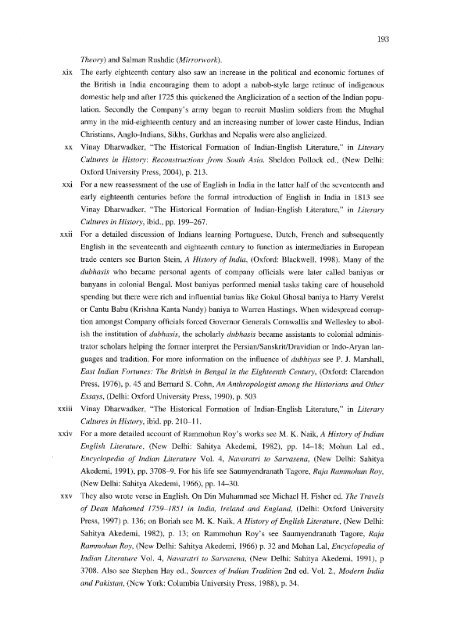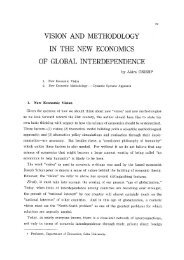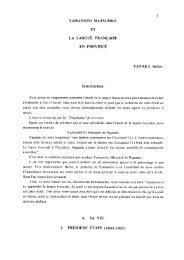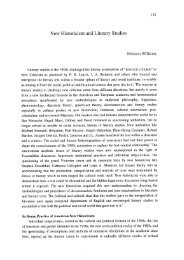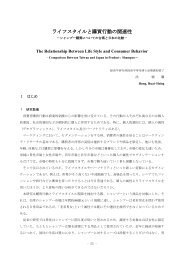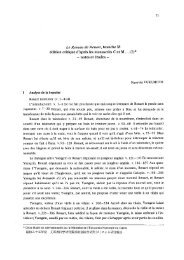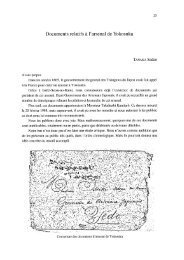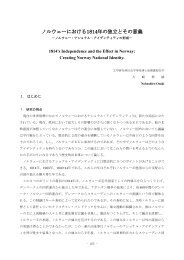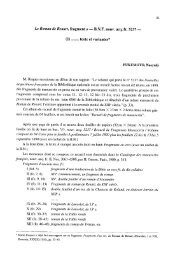Indian Writing in English 1794-2004 - Soka University Repository
Indian Writing in English 1794-2004 - Soka University Repository
Indian Writing in English 1794-2004 - Soka University Repository
You also want an ePaper? Increase the reach of your titles
YUMPU automatically turns print PDFs into web optimized ePapers that Google loves.
Theory) and Salman Rushdie (Mirrorwork).<br />
xix The early eighteenth century also saw an <strong>in</strong>crease <strong>in</strong> the political and economic fortunes of<br />
the British <strong>in</strong> India encourag<strong>in</strong>g them to adopt a nabob-style large ret<strong>in</strong>ue of <strong>in</strong>digenous<br />
domestic help and after 1725 this quickened the Anglicization of a section of the <strong>Indian</strong> popu-<br />
lation. Secondly the Company's army began to recruit Muslim soldiers from the Mughal<br />
army <strong>in</strong> the mid-eighteenth century and an <strong>in</strong>creas<strong>in</strong>g number of lower caste H<strong>in</strong>dus, <strong>Indian</strong><br />
Christians, Anglo-<strong>Indian</strong>s, Sikhs, Gurkhas and Nepalis were also anglicized.<br />
xx V<strong>in</strong>ay Dharwadker, "The Historical Formation of <strong>Indian</strong>-<strong>English</strong> Literature," <strong>in</strong> Literary<br />
Cultures <strong>in</strong> History: Reconstructions from South Asia. Sheldon Pollock ed., (New Delhi:<br />
Oxford <strong>University</strong> Press, <strong>2004</strong>), p. 213.<br />
xxi For a new reassessment of the use of <strong>English</strong> <strong>in</strong> India <strong>in</strong> the latter half of the seventeenth and<br />
early eighteenth centuries before the formal <strong>in</strong>troduction of <strong>English</strong> <strong>in</strong> India <strong>in</strong> 1813 see<br />
V<strong>in</strong>ay Dharwadker, "The Historical Formation of <strong>Indian</strong>-<strong>English</strong> Literature," <strong>in</strong> Literary<br />
Cultures <strong>in</strong> History, ibid., pp. 199-267.<br />
xxii For a detailed discussion of <strong>Indian</strong>s learn<strong>in</strong>g Portuguese, Dutch, French and subsequently<br />
<strong>English</strong> <strong>in</strong> the seventeenth and eighteenth century to function as <strong>in</strong>termediaries <strong>in</strong> European<br />
trade centers see Burton Ste<strong>in</strong>, A History of India, (Oxford: Blackwell, 1998). Many of the<br />
dubhasis who became personal agents of company officials were later called baniyas or<br />
banyans <strong>in</strong> colonial Bengal. Most baniyas performed menial tasks tak<strong>in</strong>g care of household<br />
spend<strong>in</strong>g but there were rich and <strong>in</strong>fluential banias like Gokul Ghosal baniya to Harry Verelst<br />
or Cantu Babu (Krishna Kanta Nandy) baniya to Warren Hast<strong>in</strong>gs. When widespread corrup-<br />
tion amongst Company officials forced Governor Generals Cornwallis and Wellesley to abol-<br />
ish the <strong>in</strong>stitution of dubhasis, the scholarly dubhasis became assistants to colonial adm<strong>in</strong>is-<br />
trator scholars help<strong>in</strong>g the former <strong>in</strong>terpret the Persian/Sanskrit/Dravidian or Indo-Aryan lan-<br />
guages and tradition. For more <strong>in</strong>formation on the <strong>in</strong>fluence of dubhiyas see P. J. Marshall,<br />
East <strong>Indian</strong> Fortunes: The British <strong>in</strong> Bengal <strong>in</strong> the Eighteenth Century, (Oxford: Clarendon<br />
Press, 1976), p. 45 and Bernard S. Cohn, An Anthropologist among the Historians and Other<br />
Essays, (Delhi: Oxford <strong>University</strong> Press, 1990), p. 503<br />
xxiii V<strong>in</strong>ay Dharwadker, "The Historical Formation of <strong>Indian</strong>-<strong>English</strong> Literature," <strong>in</strong> Literary<br />
Cultures <strong>in</strong> History, ibid. pp. 210-11.<br />
xxiv For a more detailed account of Rammohun Roy's works see M. K. Naik, A History of <strong>Indian</strong><br />
<strong>English</strong> Literature, (New Delhi: Sahitya Akedemi, 1982), pp. 14-48; Mohun Lal ed.,<br />
Encyclopedia of <strong>Indian</strong> Literature Vol. 4, Navaratri to Sarvasena, (New Delhi: Sahitya<br />
Akedemi, 1991), pp. 3708-9. For his life see Saumyendranath Tagore, Raja Rammohun Roy,<br />
(New Delhi: Sahitya Akedemi, 1966), pp. 14-30.<br />
xxv They also wrote verse <strong>in</strong> <strong>English</strong>. On D<strong>in</strong> Muhammad see Michael H. Fisher ed. The Travels<br />
of Dean Mahomed 1759-1851 <strong>in</strong> India, Ireland and England, (Delhi: Oxford <strong>University</strong><br />
Press, 1997) p. 136; on Boriah see M. K. Naik, A History of <strong>English</strong> Literature, (New Delhi:<br />
Sahitya Akedemi, 1982), p. 13; on Rammohun Roy's see Saumyendranath Tagore, Raja<br />
Rammohun Roy, (New Delhi: Sahitya Akedemi, 1966) p. 32 and Mohan Lal, Encyclopedia of<br />
<strong>Indian</strong> Literature Vol. 4, Navaratri to Sarvasena, (New Delhi: Sahitya Akedemi, 1991), p<br />
3708. Also see Stephen Hay ed., Sources of <strong>Indian</strong> Tradition 2nd ed. Vol. 2., Modern India<br />
and Pakistan, (New York: Columbia <strong>University</strong> Press, 1988), p. 34.<br />
193


